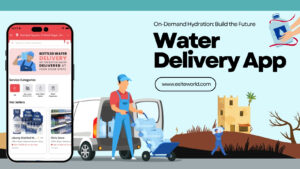The moment you read the tagline, “I’m Loving It” you immediately relate it to the “McDonald’s” logo. The same way the tagline “Just Do It” and you know it is “Nike” and so on. Similarly for the applications, you might have seen the “Uber” logo that is instantly recognizable. A brand’s development is significantly impacted by UX/UI design. People are most likely to notice the brand’s appearance first. Therefore, it’s critical for your brand to provide a positive first impression that sticks in customers’ minds.
A logo, theme colors, and fonts are only a small part of UX/UI design. It focuses mostly on giving your brand the needed consistency while also increasing the brand’s image and making it appealing to the intended audience.
UX/UI For Establishing the Brand Identity Of Your App
There is a specific history and individual background behind every prosperous company. This tale can be communicated to your customers through UI/UX branding.
A collection of visual components and graphics assets, such as a logo, brand colors, typography, illustrations, animations, and business cards, make up UI branding design. Together, they are essential for increasing brand awareness and market presence.
Never undervalue the value of user interface branding since images, colors, and fonts cause associations with your product. With the help of strategic positioning and the right messaging, brand identity enables businesses to strengthen consumer relationships. Your ultimate objective is to produce a collection of images that will set you apart from other companies and meet the demands of your particular target market.
How UI/UX Can Help You To Make Your App Brand Stand Out
The messaging of your business must be consistent with your company’s vision, objectives, and ideals. It should appear as though you are communicating directly to your audience in order to establish a distinctive atmosphere around your app brand.
It must seem as though you are communicating directly to your audience in order to establish a distinctive atmosphere around your app brand.
Your app’s user interface communicates with users in a similar way to other forms of communication. Decide what you want to say and make sure it’s all in there. As an illustration, let’s say that you’re introducing an on-demand app with a wide range of services, like Gojek.
No matter what features your Super App has to offer, your marketing efforts are completely ineffective if the user interface does not accurately reflect your brand and cannot compel your audience.
And that’s when UX/UI becomes crucial in helping you stand out from the competition, advance ahead of them, and promote your App Services swiftly.
While marketing over a variety of media, make sure your message is consistent so that users can connect with you quickly. When a customer watches your ad over any medium – be it a social media platform, TV ads, or read it in blog posts, the user experience should be consistent while highlighting the positioning of your brand.
Best Branding Practices To Follow – UX/UI of your App
Each UX/UI element of your app is the right place to infuse a bit of your brand’s personality and voice. Hence, it is important to rely on an experienced App Development Company offering competence when it comes to UI/UX.
1. Keep your layout simple and easy to understand
Consider your app’s interface carefully because it will be the first thing users will see and interact with. White space, commonly referred to as negative spaces, should balance the App’s visual design.
Avoid overcrowding your Gojek-like app’s UI with text and graphics. Not only does it become challenging to load, but your users get an overpowering feeling while using the software.
Design a user-friendly, aesthetically pleasing app interface. Getting the layout just right is made easier by using a grid approach. Making your content more readable and organized would also help.
2. The navigation should be simple and sleek
Not just when we think the user will need it, but always, navigation should be provided. Users should have no trouble understanding the menu selections thanks to the graphic elements and icons. Hidden navigation reduces engagement, impedes exploration, and confounds users.
3. Simplify the on-boarding process
Users would frequently want to figure things out on their own, thus requiring them to study more than three or four on-boarding screens or reading too much information upfront can be annoying.
The UI of an app should generally be so readily recognizable and intuitive that it does not require a tutorial.
But, if you feel the need to employ on-boarding techniques, keep the lessons’ number of stages to a minimum and if at all possible, present them solely in relation to the users’ current actions. Moreover, restrict tooltips to only a few of your app’s most crucial functionalities.
4. Prioritize your features
It is common to strive to include as many features as you can. In our opinion, omitting something will somehow make users’ experiences less satisfying. Instead, keep features narrowly focused on the primary goals and improve the design by examining the most often used features and making them both user-friendly and enjoyable.
5. Eliminate that visual noise
Borders, an excess of lines, and solid designs that look too archaic and boxy make it more difficult for your users to comprehend the content.
No such mystical formula exists, such as this is more or this side less. If there is adequate room within the composition, padding can make a distinction that is just as evident as a line if you use the space carefully.
6. Practicality over aesthetic appeal
UI and UX design are interconnected. In other words, a beautiful user interface is pointless without a great user experience. Likewise the inverse.
Customers may initially be satiated by a stunning user interface, but if the UX is subpar, they will quickly get frustrated and reliant on using your product. As a result, UI/UX designers must constantly create a balance between their UX and UI components, or on rare occasions, prioritise use over aesthetics.
Avoid letting the aesthetics of your user interface detract from your main goal of giving your users the features they need and resolving their issues. If the requirements are met, the advantages of a good interface increase.
7. Do not overlook the content importance
A key element of UI design is your app’s content, which includes both text and graphics. It significantly improves user experience overall. The text should be easy to read and understand, while the pictures should be pertinent and help consumers absorb the content quickly.
The importance of the content in UX/UI design should never be underestimated because it has a detrimental impact on the user experience.
8. Make sure that you keep the patterns and components consistent
Components and patterns like buttons, forms, menus, and dashboards should not only be formatted similarly but also behave consistently throughout the app.
As a mobile app designer, you’re developing UI systems rather than just a set of views. Before beginning a new project, experiment with multiple design systems to establish consistency. You can take help from Google’s Material Design, to ascertain which is most suitable for your users’ devices.
9. Trying everything together
Probably the worst error business owners make when creating an on-demand multi-services app.
There is no stopping the on-demand apps. The user experience may be harmed by including everything that is currently popular in UX/UI. Because of this, it’s crucial to follow best practices and comprehend the limitations a smartphone has in terms of providing a slick, user-friendly interface in order to provide the finest shopping experience.
Why UX/UI is Responsible For The Success Of Your Mobile App?
A good reputation for your Online Business, and improved brand recognition, there are ample reasons when it comes to implementing effective UI/UX.
It aids in improving brand recognition
Apps having a strong brand identification are typically used by users. An app can build an interesting community with a solid UI/UX design.
As a result, the potential users might provide you with some unique features to help you improve and update the software. The success of your business is the result of the entire mobile app design process.
You Save Time and Money
When you implement a successful UI/UX design, a good user interface results in an improved user experience. A well-designed user interface produces a great user experience. As a result, it aids in time, effort, and financial savings.
Recognize your user’s needs
A thoughtful app design demonstrates the importance of keeping users in mind. A compelling UI/UX design may also draw in the target market. You can segment all users and better understand their demands with a better app design.
If you have a thorough understanding of your target market, you may successfully convert prospective leads into more reservations and service orders.
You witness more traffic resulting in more downloads
Your app will draw more users if its UI/UX is well-designed. As a result, it will help retain current users and attract new ones, leading to increase downloads. Your software needs an appealing UI/UX design to stay ahead of the competition in this cutthroat market.
Builds customer loyalty
Having a flawless UX/UI Design makes it easier for your users to browse through the app. A great UI/UX design can greatly simplify the process of developing an app. It supports the appropriate UI, is usable, and is accessible for an app.
You must therefore create a user interface and user experience that are appropriate for both your clients and your business. It takes less time, money, and effort to create an interface with smart design.
Overall reduces the development cost
It’s difficult to create an on-demand multi-service app. It must have a perfect design that supports UI support, accessibility, and usability for apps. So, you need an impulsive and uncomplicated UI/UX design that is good for both consumers and your business. An interface that has been carefully thought out can be created with less time, money, and effort.
It increases business productivity
A well-designed app does well in terms of growth, sales conversion, and other variables. You need clear navigation and an intuitive user interface to shorten consumer search times, meet their needs, and ultimately increase customer satisfaction and corporate efficiency.
You are way ahead of your competitors
To properly expand your business, you need to be aware of your customer’s requirements. You have that opportunity to influence new users, which leads to higher conversion through a UI/UX design. Having integrated a unique app design that is easy and straightforward will keep you one step ahead of the competition.
Wrapping Up
It is well known that not every entrepreneur is proficient in technology. It’s crucial to design an All-in-One App that is both inventive and technically solid. Hire a professional technical team that is capable of creating a superb Gojek clone app while keeping in mind your consumers and business goals. A professional app development business might be useful in the long run because you will require them after the app launch as well. You will be at the top of your game in terms of business with the routine upgrades and maintenance.





